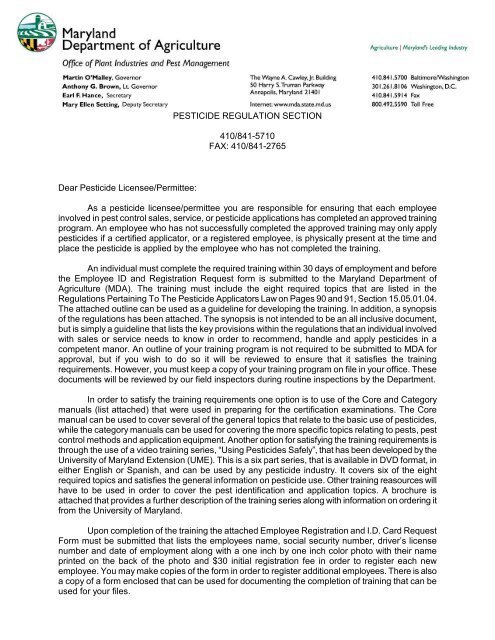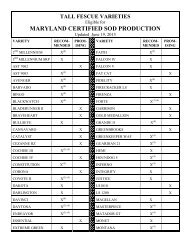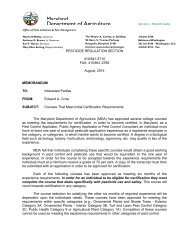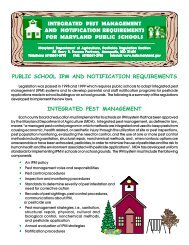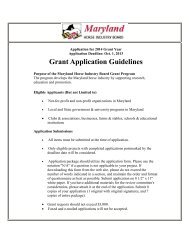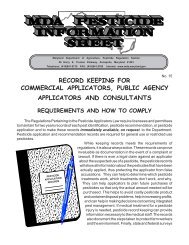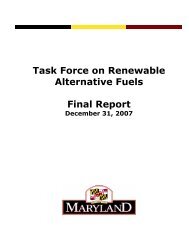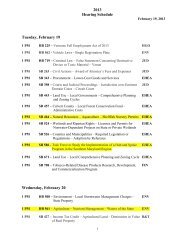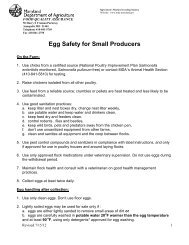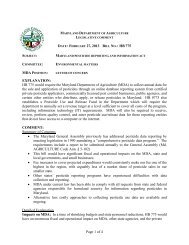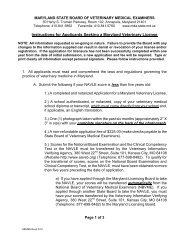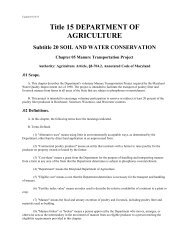Registered Employee Training Information - Maryland Department of ...
Registered Employee Training Information - Maryland Department of ...
Registered Employee Training Information - Maryland Department of ...
- No tags were found...
You also want an ePaper? Increase the reach of your titles
YUMPU automatically turns print PDFs into web optimized ePapers that Google loves.
<strong>Training</strong> StandardsPage Two5. Pest Identification and Control Recommendations – Chapter 1 pages 1 through 9 <strong>of</strong> the CoreManual and Category Manualsa. Identification <strong>of</strong> pestsb. Characteristics <strong>of</strong> damage caused by pestsc. Pest biologyd. Choice <strong>of</strong> control methods and timing <strong>of</strong> control techniques6. Pesticide Application Techniques – Chapter 10 pages 153 through 159 and Chapter 11 <strong>of</strong> theCore Manual and Category Manualsa. Procedures for applying different formulationsb. Proper placement <strong>of</strong> pesticidesc. Misuse <strong>of</strong> pesticides7. Environmental and Health Concerns – Chapter 7 <strong>of</strong> the Core Manual and Module 5 <strong>of</strong> the DVDa. Identification <strong>of</strong> sensitive areasb. Hazards to non-target organisms and endangered speciesc. Contamination <strong>of</strong> water sourcesd. Pesticide persistence and residues8. Integrated Pest Management Principles – Chapter 1 pages 10 through 16 <strong>of</strong> the Core Manualand Module 6 <strong>of</strong> the DVDa. IPM conceptsb. Monitoring pest populationsc. Integrated control techniquesRev 12/10
IIIPest Control <strong>Employee</strong>sA. Registration - Licensees and permittees must register with the <strong>Department</strong> all employeeswho perform pest control services: Pages 90 and 91 <strong>of</strong> the Regulations, Section .04A(1)(2)(3)1. Within 30 days <strong>of</strong> employment;2. By providing the employee's name, social security number and a one inch by oneinch color photo;3. By submitting verification <strong>of</strong> training;4. Paying a $30 initial registration fee.B. <strong>Training</strong> Requirements - Non-certified employees must complete a training program within30 days <strong>of</strong> employment and before registration with the <strong>Department</strong>. The training programmust include the following subjects:Page 91 <strong>of</strong> the Regulations, Section .04 B(1)1. Pesticide laws and regulations;2. Label comprehension;3. Safety and emergency procedures;4. Proper pesticide handling and storage;5. Pest identification and control recommendations;6. Pesticide application techniques;7. Environmental and health concerns; and8. Integrated pest management principles.C. A registered employee shall carry the identification card and show it to anyone uponrequest. Upon termination <strong>of</strong> employment, the registered employee shall return theidentification card to MDA. Page 91 <strong>of</strong> the Regulations, Section .04 C(1)D. If an employee has not successfully completed training they cannot apply pesticides unlessa certified applicator or registered employee is physically present at the time and place <strong>of</strong>the application. Page 91 <strong>of</strong> the Regulations, Section C(2)IV.Requirements for Storing PesticidesA. At a minimum non-bulk pesticides shall be stored according to the following requirements:Pages 93 and 94 <strong>of</strong> the Regulations, Section .06 A(1)-(9)1. The storage area shall be secured or locked to preventunauthorized access;2. Pesticides shall be stored in a separate building, or at aminimum, shall be separated by a physical barrier from livingand working areas and from food, feed, fertilizer, seed, andsafety equipment;3. A warning sign shall be placed on the exterior <strong>of</strong> the storagearea;4. Pesticides shall be stored in a dry, ventilated area;5. The pesticide storage area shall be kept clean;6. A supply <strong>of</strong> absorbent material sufficient enough to absorb a2
spill <strong>of</strong> the largest container in storage shall be kept in thestorage area;7. Pesticide containers must be properly labeled and free <strong>of</strong>leaks;8. An appropriate fire extinguisher must be available; and9. Pesticides shall be stored at least 50 feet from any water well,or be stored in secondary containment.B. During transport, pesticide containers and application equipment shall be secured toprevent shifting or release <strong>of</strong> pesticides. Pesticides may not be placed, or carried, in thesame compartment as the driver, food, or feed, unless it is in a manner that providesadequate protection for the safety and health <strong>of</strong> the passengers. Page 94 <strong>of</strong> theRegulations, Section .06 B(1)(2)C. Pesticide Service Containers. Page 94 <strong>of</strong> the Regulations Section .06 C(1)(2)1. Concentrate - If pesticide concentrate is temporarily stored ortransported its container must have a securely attached labelwith the following information:a. Common, or chemical name, <strong>of</strong> the pesticide;b. U.S. EPA registration number;c. Signal word (Danger, Warning or Caution);d. Percent concentration.2. End-Use Dilutions - If a pesticide that does not require furtherdilution is stored or transported, its container (excludingapplication equipment) must have a securely attached labelwith the following information:a. Common, or chemical name, <strong>of</strong> the pesticide preceded bythe words "Diluted" or "End-Use Concentrate";b. U.S. EPA registration number;c. Signal word (Danger, Warning or Caution);d. Percent concentration.D. A pesticide container may not be used for any purpose other than containing the originallylabeled product unless the label states otherwise. Page 94 <strong>of</strong> the Regulations, Section .06DV. Pesticide Licensing and Certification RequirementsA. Private Applicator - Issued to a farmer, nurseryman, etc., who applies a restricted usepesticide on their own property for the purpose <strong>of</strong> producing an agricultural commodity andis at least 18 years old. Obtained by: Pages 95 and 96 <strong>of</strong> the Regulations, Section .07A,B,C(1)(2),D, E(1)(2)(3)1. Passing an examination;2. Paying a $7 fee;3. Renewing every 3 years by participating in a training session within 123
months before expiration <strong>of</strong> the current certificate.B. Pest Control Applicator, Pest Control Consultant and Public Agency Applicator Certificates.Obtained by: Pages 96, 97, 98 and 99, Section .08 A(1)-(11),B(1)(2),C(1)(2)1. Being at least 18 years old and having one year <strong>of</strong> experienceacceptable to the <strong>Department</strong>;2. Passing examinations;3. Paying a $75 fee plus $25 for each additional pest control category;4. Renewing each year on July 1 by participating in a training session orreexamination. Pest control consultant certificates are renewed each year onJanuary 1.C. Pesticide Business License - Required <strong>of</strong> each business performing pest control work.Obtained by: Page 100 <strong>of</strong> the Regulations, Section .10 A(1),B(1)(2)(3), C(1)(2),D(1)1. Completing an application;2. Designating a certified pest control applicator;3. Providing pro<strong>of</strong> <strong>of</strong> insurance;4. Paying a $150 fee;5. Renewing annually on July 1.D. Pest Control Consultant License - Issued to a business providing pest control consultation(identifying pests; recommending pesticides). Obtained by: Page 100 <strong>of</strong> the Regulations,Section .10 A(2),B(1)(2)(3), D(2)1. Completing an application;2. Designating a certified pest control consultant;3. Paying a $150 fee;4. Renewing annually on January 1.E. Not-For-Hire License - Issued to a person who performs, or employees, performs pestcontrol on property that is owned by the person and open to the public. Obtained by: Page100 <strong>of</strong> the Regulations, Section .10 A(3),B(1)(2)(3), D(3)1. Completing an application;2. Designating a certified pest control applicator;3. Paying a $150 fee;4. Renewing annually on July 1.F. Public Agency Permit - Required <strong>of</strong> any public agency (unit <strong>of</strong> local, state or federalgovernment) whose employees apply any pesticides. Obtained by: Page 100-1 <strong>of</strong> the Regulations, Section .11 A,B,C,D1. Completing an application;2. Designating a certified public agency applicator;3. Renewing annually on July 1.4
VI.Recordkeeping Requirements Pages 100-1 and 101 <strong>of</strong> the Regulations, Section .12 A - LA. Pest Identifications, Pesticide Recommendations, Pesticide Applications - Records mustbe held for 2 years and be available to the <strong>Department</strong> on request. The following must berecorded, when applicable:1. Name <strong>of</strong> applicator or consultant;2. Date <strong>of</strong> application, recommendation, or pest identification;3. Type <strong>of</strong> plant, animal or structure and pest;4. Acreage or numbers <strong>of</strong> plants or animals or a description <strong>of</strong>, orsquare footage, cubic footage or linear footage <strong>of</strong> structures;5. Address <strong>of</strong> treated property;6. Name <strong>of</strong> owner or tenant <strong>of</strong> property;7. Common name and EPA registration number <strong>of</strong> pesticide orpesticides used or recommended;8. Rate and concentration <strong>of</strong> pesticide used or recommended;9. Total amount <strong>of</strong> pesticide used;10. Type <strong>of</strong> equipment used;11. Time <strong>of</strong> day <strong>of</strong> application; and12. The direction and estimated velocity <strong>of</strong> the wind at the site <strong>of</strong>application unless the application consists <strong>of</strong> baits in baitstations or is made within 3 feet <strong>of</strong> a structure.VII.EnforcementA. Violative Acts - The <strong>Department</strong> may issue a civil penalty, suspend, revoke, or deny anylicense, certificate, permit, or registered employee identification card for violating anyprovision <strong>of</strong> the <strong>Maryland</strong> Pesticide Applicators Law and Regulations, or the FederalInsecticide, Fungicide and Rodenticide Act. Pages 102-7 and 102-8 <strong>of</strong> the Regulations,Section.18 A(1)-(17),B,CB. Civil Penalties - The Secretary <strong>of</strong> Agriculture may impose a penalty <strong>of</strong> not more than$2,500 for a first <strong>of</strong>fense and a penalty <strong>of</strong> not more than $5,000 for a repeat <strong>of</strong>fense and itmay not exceed $25,000. This can be in lieu <strong>of</strong> or in addition to suspension <strong>of</strong> the license,permit, certificate, or registered employee identification card. Page 102-9 <strong>of</strong> theRegulations, Section .20 A,B(1)-(6),C,DVIII.Additional Requirements - For further information on these requirements you must check theRegulations.A. Dealers <strong>of</strong> Restricted Use Pesticides - Pages 101 and 102 <strong>of</strong> the Regulations, Section .13A,B(1)-(5),C,D(1)(2), E(1)-(5)B. Standards for Inspection for Pests - Pages 102, 102-1 and 102-2 <strong>of</strong> the Regulations,Section .14 A(1)-(4),BC. Posting <strong>of</strong> Signs - Pages 102-2, 102-3 and 102-4 <strong>of</strong> the Regulations, Section .15 A,B(1)-(8),C,D(1)(2)(3),E,F,GD. Pesticide <strong>Information</strong> for Customers - Page 102-5 <strong>of</strong> the Regulations, Section .16 A(1)-(6)(a)(b)(c),B(1)-(3),C,D5
E. List <strong>of</strong> Pesticide Sensitive Individuals - Pages 102-6 and 102-7 <strong>of</strong> the Regulations, Section.17 A(1)(2)(3),B(1)-(6),C(1)(2)THIS SYNOPSIS IS INTENDED TO PROVIDE A QUICK REFERENCE OF THE REGULATIONSTHAT WILL PERTAIN TO REGISTERED EMPLOYEES. IT DOES NOT TAKE THE PLACE OF THEREGULATIONSRev 12/106
STUDY MATERIAL SUPPLIERSFOR PESTICIDE CERTIFICATION EXAMINATIONSApplicants for certification as a Pest Control Applicator, Public Agency Applicator or Pest Control Consultantare responsible for obtaining the study material. The following is a listing <strong>of</strong> the study material used inconjunction with <strong>Maryland</strong>’s pesticide certification examinations. This listing, by pest control category, providesthe title <strong>of</strong> the appropriate manual and the name <strong>of</strong> the supplier. Contact information for each <strong>of</strong> the suppliers islisted at the end <strong>of</strong> this document. The Core is not considered a Category <strong>of</strong> Pest Control, but everyoneseeking initial certification in <strong>Maryland</strong> must take and pass the Core examination in order to become certified,except for the following categories where Core material is contained within the study material: Wood Treatmentand Sewer Root Control (Categories 11 A and 11 C). Should you have any further questions regarding themanuals used for the pesticide certification examinations, or the certification process, please contact the<strong>Maryland</strong> <strong>Department</strong> <strong>of</strong> Agriculture (MDA), Pesticide Regulation Section, at (410)841-5710. Note: TheRegulations Pertaining To The Pesticide Applicators Law are also part <strong>of</strong> the materials used for the certificationexaminations. If you received your application through the mail a copy <strong>of</strong> the regulations should have beenprovided at that time. In the event you obtained your application over the internet a copy <strong>of</strong> the regulations canbe obtained from MDA, or they are also available through a link on the internet at the <strong>Department</strong>’s website -www.mda.maryland.gov.Category or Subcategory Title SourceCore <strong>Maryland</strong> Pesticide Application Series University <strong>of</strong> <strong>Maryland</strong>Core Manual COR-1-BAgricultural - Plant (1 A) <strong>Maryland</strong> Pesticide Application Series - University <strong>of</strong> <strong>Maryland</strong>Agricultural ManualAgricultural - Animal (1 B) Agricultural - Animal Cornell UniversityAgricultural - Grain Treatment (1 C) Stored Grain Pest ControlPublication MISC 0157Washington State UniversityForest (2) Forest Cornell UniversityOrnamental Plant - Exterior (3 A) <strong>Maryland</strong> Pesticide Application Series - University <strong>of</strong> <strong>Maryland</strong>Ornamentals & Turf ManualOrnamental Plant - Interior (3 B) Interior Plantscape Pest Control Washington State UniversityPublication MISC 0176Turf (3 C) <strong>Maryland</strong> Pesticide Application Series - University <strong>of</strong> <strong>Maryland</strong>Ornamentals & Turf ManualSeed Treatment (4) Seed Treatment Washington State UniversityPublication MISC 0199Aquatic (5) <strong>Maryland</strong> Pesticide Applicator Series - University <strong>of</strong> <strong>Maryland</strong>Aquatic Pest Control AQU-1-ARight-<strong>of</strong>-Way and Weed (6) Right-<strong>of</strong>-Way Cornell UniversityGeneral Pest Control (7 A) Structural and Rodent Cornell UniversityWood Destroying Insects (7 B) Termite Cornell UniversityWildlife Control (7 C) * Wildlife Control <strong>Maryland</strong> Dept. <strong>of</strong> AgricultureRodent Control (7 D) * Rodent Control <strong>Maryland</strong> Dept. <strong>of</strong> AgricultureFumigation (7 E) Fumigation Cornell University1
STUDY MATERIAL SUPPLIERS (con’t)Category or Subcategory Title SourcePublic Health (8) * <strong>Maryland</strong> Pesticide Applicator Manual <strong>Maryland</strong> Dept. <strong>of</strong> AgriculturePublic HealthRegulatory (9) <strong>Maryland</strong> Pesticide Application Series - University <strong>of</strong> <strong>Maryland</strong>Agricultural ManualDemonstration and Research (10) * Demonstration and Research<strong>Maryland</strong> Dept. <strong>of</strong> AgricultureWood Treatment (11 A) * + Wood Preservation and Wood Products <strong>Maryland</strong> Dept. <strong>of</strong> AgricultureTreatmentSewer Root Control (11 C) + Sewer Line Root Control Cornell UniversityAerial (13) Aerial Application Penn State UniversityPEP 25* Note: The <strong>Maryland</strong> Dept. <strong>of</strong> Agriculture will continue to provide copies <strong>of</strong> these study materials until furthernotice. They will be provided upon approval <strong>of</strong> the application.+ The following categories are not required to take the Core examination since the Core material is containedwithin the Category study material: Wood Treatment and Sewer Root Control (Categories 11 A and 11 C).STUDY MATERIAL SUPPLIERSUniversity <strong>of</strong> <strong>Maryland</strong><strong>Maryland</strong> <strong>Department</strong> <strong>of</strong> AgricultureUniversity Book CenterPesticide Regulation SectionAdele Stamp Student Union, Bldg. 16350 Harry S. Truman ParkwayCollege Park, MD 20742 Annapolis, MD 21401Telephone: (301)314-2718 Telephone: (410)841-5710Internet: http://umcp.bncollege.com/webapp/wcs/stores/servlet/TBWizardView?catalogid=10001&langld=-1&storeld=15551NOTE: See Attached Sheet On OrderingCornell UniversityThe Pennsylvania State UniversityThe Cornell StorePublications and Distribution Center135 Ho Plaza 112 Agricultural Administration BuildingIthaca, NY 14853 University Park, PA 16802-2602Telephone: (607)255-4111 Telephone: (1-877)345-0691Internet: https://store.cornell.eduInternet: www.pested.psu.edu/applicators/packets.shtmlWashington State UniversityBulletin OfficeCooper Publications BuildingP.O. Box 645912Pullman, WA 99164-5912Telephone: (800)723-1763Internet: https://pubs.wsu.eduRev 5/142
UNIVERSITY <strong>of</strong> MARYLAND MANUALS FOR PESTICIDE APPLICATORS SEEKINGCERTIFICATIONIndividuals who need to use pesticides to become certified to work for a Pest Control Business, Public Agency, or PestControl Consultant must show that they are competent to apply pesticides by passing a certification examinationadministered by the <strong>Maryland</strong> <strong>Department</strong> <strong>of</strong> Agriculture. Manuals in the Pesticide Applicator <strong>Training</strong> Series areused to provide self-help training for applicators studying to take certification exams in <strong>Maryland</strong>. The following<strong>Maryland</strong> Pesticide Applicator manuals are available as described in the section below:oooooCore Manual for Private ApplicatorsCore manual for Commercial ApplicatorsAgricultural ManualOrnamentals & Turf ManualAquatic Pest Control ManualFor manuals to help prepare for other categories, visit the <strong>Maryland</strong> <strong>Department</strong> <strong>of</strong> Agriculture website.How to Obtain Manuals -- Commercial ApplicatorsManuals for Commercial Applicators may be purchased directly from the University <strong>of</strong> <strong>Maryland</strong> Book Center (the<strong>of</strong>ficial bookstore for University <strong>of</strong> <strong>Maryland</strong>, College Park) either on-line or through the mail.• TO PURCHASE ON-LINE WITH CREDIT CARD – Access the University Book Center(http://umcp.bncollege.com/webapp/wcs/stores/servlet/TBWizardView?catalogId=10001&langId=-1&storeId=15551) and makeselections as described below:1. TERM – Leave this choice as it appears on the site.2. DEPARTMENT – Select ENTM (Entomology).3. COURSE – Select the manual you want from the drop-down list:o AGRIC (Agricultural Manual)o AQUATIC (Aquatic Pest Control Manual)o CORE (Core Manual for Commercial Applicators)o ORN & TURF (Ornamentals and Turf Manual)4. SECTION – Select MANUAL.5. To add another manual, repeat the process on another line.6. When you have finished selecting the manual(s) you want to purchase, click on the button FIND MATERIALS.7. On the next screen, at SELECT FORMAT, choose BUY NEW. (Note: For textbooks for regular courses oncampus, the Bookstore <strong>of</strong>fers a default choice <strong>of</strong> “buy used” at a default discounted rate; however, there areno used manuals for pesticide applicators.)8. Click on the button ADD ITEM(S) TO CART.9. On the next screen, check to make sure the item(s) listed is/are correct. To change your order, click on EDIT(in red, at the top right-hand corner <strong>of</strong> each item). You will then be able to update the quantity (fill in thenumber you want and click on UPDATE) or remove an item (click on REMOVE and then choose OK).3
How to Obtain Manuals -- Commercial Applicators (con’t)10. Click on CHECKOUT and follow the directions on-line to complete your purchase. Note that you may chooseto set up an account, or you may simply continue as a guest.• TO PURCHASE THROUGH THE MAIL WITH CHECK OR MONEY ORDER –1. Write a letter identifying the title and quantity <strong>of</strong> the manual(s) you want:o Core Manual for Commercial Applicatorso Agricultural Manualo Ornamentals and Turf Manualo Aquatic Pest Control Manual2. Include your check or money order for the correct amount. If you have Internet access, you can follow theprocedures above to determine the cost <strong>of</strong> the manual(s), including tax plus shipping. If you do not haveInternet access, or you cannot determine the final cost, call the Book Center at 301-314-2718.3. Be sure to include your mailing address and a contact number.4. Mail your letter and your check or money order to:Atttn: Textbook Manager / Pesticide Applicator ManualsUniversity Book CenterAdele Stamp Student Union, Bldg. 163University <strong>of</strong> <strong>Maryland</strong>College Park, MD 20742• CONTACT NUMBER FOR QUESTIONSoFor questions about purchasing Commercial Applicator Manuals, or to check on your order, call the BookCenter textbook manager at 301-314-2718.5/22/144
Educating People to Help ThemselvesUniversity <strong>of</strong> <strong>Maryland</strong> Extension programs are opento all citizens without regard to race, color, gender,disability, religion, age, sexual orientation,marital or parental status, or national origin.University <strong>of</strong> <strong>Maryland</strong> ExtensionUniversity <strong>of</strong> <strong>Maryland</strong> • College ParkCollege Park, <strong>Maryland</strong> 20742This DVD is copyrighted material fromthe University <strong>of</strong> <strong>Maryland</strong> Extensionand is intended for educational use only.Unauthorized distribution is strictly prohibited.Produced in cooperation withU.S. EPA and EPA Region 3.revised November 2010
Ideal for educating new employees as wellas for updating experienced applicators, thisfast-paced series is packed with essentialinformation and standards on pesticide safety.Each module is pr<strong>of</strong>essionally narrated and recreatesapplication situations that are crucial forevery employee to handle correctly. The seriesis available in either Spanish or English.Shot on location, this tightly edited series isdesigned to hold the attention <strong>of</strong> viewers. A specialpreview prompted the following comments:“A lot <strong>of</strong> information in a short film.”“Easy to pay attention to.”“Well done and useful overall.”“Very well put together … straightforward …very clear with good explanations.”Among the many points covered are the importantrole <strong>of</strong> EPA regulations and laws, understandingand using the label, the types <strong>of</strong> safety equipmentrequired for most jobs, and safe methods fortransporting, mixing, and storing pesticides. Youalso learn how to clean up pesticide spills, minimizeworker exposure, and avoid contaminating theenvironment.On-screen self-tests, printed questions andanswers, and a discussion guide help employersmake sure their employees understand essentialinformation.Module 1: Time: 9:32Pesticide Laws and RegulationsCovers FIFRA; the roles <strong>of</strong> EPA, FDA, andstate and local governments; and the principles<strong>of</strong> Right-to-Know laws. The written discussionguide also provides information about state lawsand regulations using <strong>Maryland</strong> as a model;other states can substitute their own information.Module 2: Time: 12:02The Pesticide LabelPresents how and when to read the label, andidentifies the various components <strong>of</strong> the label.Module 3: Time: 13:05Protecting the Pesticide HandlerExplains the routes <strong>of</strong> exposure; potentialadverse health effects, including acute and chroniceffects as well as sensitivity; selection, use,and cleaning <strong>of</strong> protective gear; and emergencyprocedures.Module 4: Time: 10:48Guidelines for Proper Pesticide HandlingShows correct procedures for storing,transporting, mixing, applying, and disposing <strong>of</strong>pesticides. Examines a storage facility and describestriple rinse disposal.Module 5: Time: 10:55Pesticides and the EnvironmentFocuses on how poor work habits withpesticides can contaminate our environment.Shows a pesticide spill and what actions to taketo clean it up. Explains the importance <strong>of</strong> usingsafe practices to protect wildlife and endangeredspecies.Module 6: Time: 11:20Integrated Pest ManagementExplains the components <strong>of</strong> Integrated PestManagement (IPM). Shows monitoring for pestsand beneficial insects and explains the concept <strong>of</strong>economic and aesthetic thresholds.Project DirectorAmy E. Brown, Ph.D.Pesticide Safety Education CoordinatorNameCompanyAddressCityStatePhoneTo order your copies, send check or money orderpayable to University <strong>of</strong> <strong>Maryland</strong> to:Administrative Assistant<strong>Department</strong> <strong>of</strong> Entomology4112 Plant Sciences BuildingUniversity <strong>of</strong> <strong>Maryland</strong>College Park, MD 20742(301) 405-3913Or order online at:http://pesticide.umd.edu/orderUsingPesticidesSafelyZipEach DVD includes all 6 modules. $120.00/DVDEnglish(quantity)SpanishTotal Payment(quantity)
MARYLAND DEPARTMENT OF AGRICULTUREOFFICE OF PLANT INDUSTRIES AND PEST MANAGEMENTPESTICIDE REGULATION SECTION50 Harry S. Truman ParkwayAnnapolis, <strong>Maryland</strong> 21401Telephone: 410/841-5710FAX: 410/841-2765FOR DEPARTMENTAL USE ONLYEMPLOYEE REGISTRATION AND I.D. CARD REQUESTComplete the following information to register a new employee and to request an I.D. card. EffectiveJanuary 1, 2011 there is a $30 fee for registering each new employee (fees do not apply to IDcards issued for public agencies, certified applicators or replacement ID cards). Submit appropriatefees with application. Make checks payable to the <strong>Maryland</strong> <strong>Department</strong> <strong>of</strong> Agriculture. Please note,the Pesticide Regulation Section does not have the authority to prorate fees. <strong>Employee</strong> Registrations will expireJune 30, regardless <strong>of</strong> the date issued.NOTE: This form does not serve as a Change In Status form for a Certified Applicator when there is achange in employment.1. PLEASE TYPE OR PRINT LEGIBLY:Date Appl. Received __________________Date Fees Received __________________Fees Submitted :Check No. ___________ Cash: _______Acct. No. __________ Ref. No. _________Date Mailed __________________________________________________________________________________________________________BUSINESS OR AGENCY NAMEBUSINESS OR PERMIT NUMBER_________________________________________________________________________________STREETCITY_________________________________________________________________________________STATE ZIP CODE TELEPHONE NUMBER2. FEES: Number <strong>of</strong> <strong>Employee</strong>s To Be <strong>Registered</strong>: __________ Fees Submitted: __________3. APPLICATION MUST BE SIGNED BY LICENSEE OR PERMIT HOLDERI hereby verify that the individual(s) listed on this form have successfully completed training in accordancewith Section 15.05.01.04 et seq. Annotated Code <strong>of</strong> <strong>Maryland</strong> <strong>of</strong> the Regulations Pertaining ToThe Pesticide Applicators Law._________________________________________________________________________________Signature <strong>of</strong> Licensee or Permit HolderDateFalsification <strong>of</strong> any information could result in a Civil Penalty assessment orplace your Business License, Permit or Certificate in jeopardy.○ ○ ○ ○ ○ ○ ○ ○ ○ ○ ○ ○ ○ ○ ○ ○ ○ ○ ○ ○ ○ ○ ○ ○ ○ ○ ○ ○ ○ ○ ○ ○ ○ ○ ○ ○ ○ ○ ○ ○ ○ ○ ○ ○ ○ ○ ○ ○ ○ ○ ○ ○ ○ ○ ○ ○ ○ ○ ○ ○ ○ ○ ○ ○ ○ ○ ○ ○4. Include a 1 inch by 1 inch color photo <strong>of</strong> each employee with the employee name printed on theback. Please list the certificate number only if the employee is currently certified.NOTE: AN ID CARD CANNOT BE ISSUED UNLESS A PHOTO ACCOMPANIES THE REQUEST.(OVER)
25. PLEASE TYPE OR PRINT LEGIBLY:Is this a (Check One): New Card ( ) Replacement Card ( )<strong>Employee</strong> Name: ____________________________________________________________________________________<strong>Employee</strong> Social Security Number: ___________ <strong>Employee</strong> Driver’s License Number& State: ______________________Date <strong>of</strong> Employment: ___________________ Certificate Number if Currently Certified: ___________________________Date <strong>Training</strong> Program Was Completed: __________________________________________________________For Office Use Only: Reference No.: __________ Control No.: ___________ ID No.: ____________Is this a (Check One): New Card ( ) Replacement Card ( )<strong>Employee</strong> Name: ____________________________________________________________________________________<strong>Employee</strong> Social Security Number: ___________ <strong>Employee</strong> Driver’s License Number& State: ______________________Date <strong>of</strong> Employment: ___________________ Certificate Number if Currently Certified: ___________________________Date <strong>Training</strong> Program Was Completed: __________________________________________________________For Office Use Only: Reference No.: __________ Control No.: ___________ ID No.: ____________Is this a (Check One): New Card ( ) Replacement Card ( )<strong>Employee</strong> Name: ____________________________________________________________________________________<strong>Employee</strong> Social Security Number: ___________ <strong>Employee</strong> Driver’s License Number& State: ______________________Date <strong>of</strong> Employment: ___________________ Certificate Number if Currently Certified: ___________________________Date <strong>Training</strong> Program Was Completed: __________________________________________________________For Office Use Only: Reference No.: __________ Control No.: ___________ ID No.: ____________Is this a (Check One): New Card ( ) Replacement Card ( )<strong>Employee</strong> Name: ____________________________________________________________________________________<strong>Employee</strong> Social Security Number: ___________ <strong>Employee</strong> Driver’s License Number& State: ______________________Date <strong>of</strong> Employment: ___________________ Certificate Number if Currently Certified: ___________________________Date <strong>Training</strong> Program Was Completed: __________________________________________________________For Office Use Only: Reference No.: __________ Control No.: ___________ ID No.: ____________MDA-D-351 Rev. 7/12
VERIFICATION OF REGISTERED EMPLOYEE TRAINING________________________________________Business/Agency Name_______________________MDA License/Permit NumberSignature <strong>of</strong><strong>Employee</strong> Name Soc. Sec. No. <strong>Training</strong> Date <strong>Employee</strong> Signature Certified Applicator1.2.3.4.5.6.7.8.9.10.11.12.13.14.15.16.17.18.19.20.21.
MARYLAND DEPARTMENT OF AGRICULTUREOFFICE OF PLANT INDUSTRIES AND PEST MANAGEMENTPESTICIDE REGULATION SECTION50 Harry S. Truman ParkwayAnnapolis, <strong>Maryland</strong> 21401Telephone: 410/841-5710FAX: 410/841-2765FOR DEPARTMENTAL USE ONLYDate Received ________________Date Processed ______________TERMINATION OF REGISTERED EMPLOYEE AND / OR CERTIFIED APPLICATORPLEASE TYPE OR PRINT LEGIBLY:Business / Public Agency Name: _______________________________________________________________Street: __________________________________________________________________________________________City / State / Zip Code: __________________________________________________________________________Business License / Agency Permit No.: ___________________ Telephone No.: ___________________EMPLOYEENAMEEMPLOYEE SOCIALSECURITY NO.INDICATE IFREGISTERED orPROVIDE CERT. NO.DATE OFTERMINATIONINDICATE IF IDCARD IS RETURNED1.2.3.4.5.6.7.8.9.10.Name Of Authorized Individual: _____________________________________________________Name - Please PrintSignature <strong>of</strong> Authorized Individual: __________________________________________________Please SignDate: ___________________
<strong>Maryland</strong> <strong>Department</strong> <strong>of</strong> Agriculture, Pesticide Regulation Section50 Harry S. Truman Parkway, Annapolis, <strong>Maryland</strong> 21401Telephone: (410)841-5710 FAX: (410)841-2765 Internet: www.mda.maryland.govPESTICIDE APPLICATOR CERTIFICATION ANDBUSINESS LICENSING REQUIREMENTSA pesticide is defined as any substance used to control, prevent, destroy, repel, or mitigate any pest. Pestsinclude insects, weeds, plant diseases, nematodes, fungi, birds, rodents, snails, and slugs. Herbicides,insecticides, fungicides, miticides, growth regulators, desiccants, and rodenticides are a few <strong>of</strong> the materialscategorized as pesticides. Under the Federal Insecticide, Fungicide, and Rodenticide Act (FIFRA), administeredby the United States Environmental Protection Agency (EPA), pesticides must be registered with EPAprior to their sale or distribution. As part <strong>of</strong> the registration process, pesticides are classified for either generaluse or restricted use. EPA bases this classification on the pesticide's potential for harm, its formulation, method<strong>of</strong> use, and site <strong>of</strong> application. A pesticide that is not likely to harm humans or the environment when usedaccording to label directions is classified as a general use pesticide. If there is reason to believe that a pesticidemay harm humans or the environment, even when used according to label directions, it will be classified asa restricted use pesticide. Restricted use pesticides can only be applied by or under the direct supervision <strong>of</strong>certified pesticide applicators.The <strong>Maryland</strong> <strong>Department</strong> <strong>of</strong> Agriculture (MDA) is responsible for regulating the sale, use, storage, anddisposal <strong>of</strong> pesticides and for enforcing the <strong>Maryland</strong> Pesticide Applicators Law. MDA is responsible forestablishing guidelines and requirements for the application <strong>of</strong> pesticides, the certification <strong>of</strong> pesticideapplicators and the licensing <strong>of</strong> businesses to ensure that pesticides are applied properly by competentindividuals.There are several different types <strong>of</strong> pesticide applicator certificates and licenses issued by MDA,including: private applicator certificates, pesticide business licenses, pest control applicator certificates, pestcontrol consultant licenses, pest control consultant certificates, public agency permits, public agencyapplicator certificates, and "not-for-hire" business licenses and pesticide applicator certificates.PRIVATE APPLICATORNo. 14A private applicator is a person who uses a restricted use pesticide in the production <strong>of</strong> an agriculturalcommodity on their own or leased property, such as dairy farms, orchards, nurseries, turf farms andgreenhouses. In order to become certified as a private applicator, the individual must be at least 16 years <strong>of</strong>age and pass a written closed book certification examination administered by MDA with a score <strong>of</strong> 70% or higher. The examination consists <strong>of</strong> multiple choice questions on core, regulations and label interpretation. Subjectmatter contained in the examination is based on the Core training manual that is available from the county <strong>of</strong>fices<strong>of</strong> the University <strong>of</strong> <strong>Maryland</strong> Extension (UME). The examination dates are scheduled by the county <strong>of</strong>fices<strong>of</strong> the UME. The UME provides pesticide education to <strong>Maryland</strong> applicators. The county extension educators
<strong>of</strong>fer optional training sessions to assist applicators in preparing for the examination. Upon completion <strong>of</strong> thecertification exam, the person will be notified, in 2 to 3 weeks, <strong>of</strong> the test results and after passing the exam,the person will be instructed to submit $7 to MDA for the certificate. The private applicator certificate runs fromJanuary 1 through December 31 and is valid for three years.In order for a private applicator to renew their certificate, they are required to attend an MDA-approvedrecertification training session during the last year <strong>of</strong> the current certification period. Recertification trainingprovides applicators with new information on pest control, health and environmental safety, pest managementtechnology, and changes in pesticide laws and regulations to help the applicator continue to use pesticidessafely and effectively. The training must consist <strong>of</strong> a minimum <strong>of</strong> 4 credits (1 credit is equal to ½ hour <strong>of</strong> training),that is the equivalent <strong>of</strong> two hours <strong>of</strong> pest or pesticide related topics as determined by MDA and UME.Attendance at initial certification training will not satisfy the requirements for recertification training. Therequired topics that must be covered in each recertification session changes as the need arises and a listing<strong>of</strong> these topics along with optional topics is available from MDA. The sponsor <strong>of</strong> a recertification session mustsubmit a copy <strong>of</strong> the meeting agenda to MDA for approval at least two weeks prior to the recertification session.The sponsor is also responsible for providing MDA with verification <strong>of</strong> attendance for each individual seekingrecertification credit. The verification form must include the participants printed name, address and certificatenumber. Upon receiving the verification <strong>of</strong> attendance, MDA will update each private applicator's trainingrecords. Renewal forms are issued in late November to applicators that have satisfied the training requirementsand whose private applicator certificates are about to expire.COMMERCIAL PEST CONTROLA pesticide business is any business that is <strong>of</strong>fering pest control services or is applying general orrestricted use pesticides for hire as part <strong>of</strong> a service or contract agreement. Pest control means engagingin, or <strong>of</strong>fering to engage in, recommending, advertising, soliciting the use <strong>of</strong>, supervising the use <strong>of</strong>, or using,a pesticide or device for the identification, control, eradication, mitigation, detection, inspection, or prevention<strong>of</strong> a pest in, on, or around any house, building, water, air, land, plant, structure, or animal. This includes lawncare companies using weed and feed or organic pesticides, landscapers using Roundup or animal repellents,and firms providing structural pest control, including the use <strong>of</strong> devices using heat or freezing. A pesticidebusiness license is required in order to provide these services.Licensing - In order to obtain a pesticide business license, a firm must complete an application obtainedfrom MDA, designate at least one person certified as a pest control applicator in the categories in which theyare providing pest control services, pay a $150 annual business license fee, and provide pro<strong>of</strong> <strong>of</strong> generalliability insurance as follows:Bodily Injury - $100,000 each person and $300,000 each occurrenceProperty Damage - $15,000 each occurrence and $30,000 annual aggregate provisionAn original copy <strong>of</strong> the current Certificate <strong>of</strong> Insurance must be kept on file with MDA. The licensing periodruns from July 1 through June 30.Certification - In order to become certified as a pest control applicator, an individual must be at least 18years <strong>of</strong> age and have at least one year <strong>of</strong> practical pesticide application experience as a registered employeein the category, or categories, in which they want to become certified. A degree in a biological field such asbiology, botany, horticulture, entomology, agronomy, etc., or the completion <strong>of</strong> specific courses approved byMDA can be used in lieu <strong>of</strong> experience. The individual must pass examinations administered by MDA.In order to qualify for the examinations, an applicant must submit an application for certification obtainedfrom MDA at least one month prior to the examination. Experience or education documentation such as theVerification <strong>of</strong> Experience Forms or college transcripts must be attached. Applications are available on MDA'sweb site as a PDF file at www.mda.maryland.gov. A listing <strong>of</strong> the manuals and suppliers used in preparationfor taking the examinations is attached as part <strong>of</strong> the application form. Upon approval <strong>of</strong> the application, MDAwill mail an approval letter with further information on the examination process. A notification will be mailed tothe applicants home address approximately two weeks prior to the examination listing the dates and locations.MDA <strong>of</strong>fers the commercial examinations every other month in Annapolis, Salisbury and Frederick.2
Examinations are multiple-choice and closed book. Each applicant must pass the Core examination whichcovers basic pesticide information and laws and at least one specific category examination with a score <strong>of</strong> 70%or higher. Please note, that the Core is not considered a Category <strong>of</strong> Pest Control. The last page <strong>of</strong> thisdocument provides a listing <strong>of</strong> the pest control categories and subcategories.An individual may retake the exams as many times as is necessary. However, there is a $10 retake feepaid at the time <strong>of</strong> reexamination for each examination that is retaken. Upon passing the exams, a $75 annualcertification fee must be paid for the initial category, and a $25 fee for each additional main category (numericdesignation) <strong>of</strong> certification. The fees are only assessed for a category, not for subcategories (letterdesignation). There are no additional fees for certification in multiple subcategories under one category.Regulations prohibit an individual from maintaining certification for more than one place <strong>of</strong> business at a time.In addition, a certificate cannot be transferred to another person, and MDA must be notified immediately whena certified applicator is no longer employed by a licensee or permittee.Recertification - <strong>Maryland</strong> requires all certified applicators (including out-<strong>of</strong>-state applicators who werecertified based on reciprocity - refer to the section on reciprocity) to attend recertification training each yearin order to renew their certificate. If applicators are certified in multiple categories they must attendrecertification for each category in which they are certified. The training does not have to be held in <strong>Maryland</strong>.In order for a meeting to qualify for recertification credit, a copy <strong>of</strong> the meeting agenda must be submitted toMDA for approval. (Note: Before a meeting can be advertised for recertification credit in <strong>Maryland</strong> it mustbe submitted to MDA at least 2 weeks prior to the meeting and be approved). If the meeting has not beensubmitted by the meeting sponsor for recertification credit in <strong>Maryland</strong>, a copy <strong>of</strong> the meeting agenda needsto be submitted by the applicator to MDA for approval. In order for an individual to become recertified, theymust obtain the following credits on an annual basis: Categories 1, 3, 7, 8, 9 and 13 must receive eight credits;Categories 2, 5, and 6 must receive six credits; Category 10 must attend recertification training that pertainsto the area <strong>of</strong> their work. All other categories are determined on a case by case basis. (1 credit is equal to ½hour <strong>of</strong> training.)In order for a meeting to receive recertification credit it must cover new laws, regulations or policies alongwith new technology. Integrated Pest Management (IPM) principles and methodologies should be incorporatedinto the program along with a combination <strong>of</strong> the following topics: pesticide safety; environmental concerns;pest biology; control techniques; storage; and disposal. Sponsors <strong>of</strong> the recertification sessions must ensurethat individuals needing recertification credit attend the appropriate sessions and submit documentation toMDA that each individual has satisfied the training requirements. Documentation includes each participant'sname and certificate number. If the meeting was not submitted by the sponsor, documentation <strong>of</strong> attendancemust be supplied to MDA by the applicator. Certificates <strong>of</strong> completion or similar documentation can be used.Upon submission <strong>of</strong> pro<strong>of</strong> <strong>of</strong> training, MDA will update the certified applicator's training records and arenewal form will be mailed to the applicator in April. If a certified applicator does not attend recertificationtraining, or provide MDA with pro<strong>of</strong> <strong>of</strong> attendance, the applicator must retake the certification examinationsby June 30 in order to renew the certificate.NOTE: A business license or certificate is not considered valid until all the requirements aresatisfied and MDA receives the appropriate fees and renewal forms.PEST CONTROL CONSULTANTA pest control consultant license and certificate are required if a person is engaged in the business <strong>of</strong><strong>of</strong>fering or supplying technical advice or supervision, inspecting for or identifying pests, or recommending theuse <strong>of</strong> specific pesticides for the purpose <strong>of</strong> controlling pests. The requirements and procedures for obtainingand maintaining a pest consultant business license and certificate are the same as that for a pesticide businesslicense and pest control applicators certificate, except for the following differences: (1) The licensing andcertification period runs from January 1 through December 31 <strong>of</strong> each year; (2) There are no insurancerequirements for maintaining a consultant license; (3) A pest control consultant will be certified in Category12 - Consulting, Note - Certification in this category is based on experience, or education, and passing thecertification examinations in those categories <strong>of</strong> pest control that consulting services will be <strong>of</strong>fered; (4) Theannual pest control consultant license fee is $150 and the pest control consultant certificate fee is $75.3
Those individuals certified as Consultants are required to attend recertification training each yearbetween January 1 and December 31 in order to renew their certificate. The recertification trainingrequirements will be based <strong>of</strong>f <strong>of</strong> the categories <strong>of</strong> pest control that were originally taken for certification andin which consulting services are being <strong>of</strong>fered.PUBLIC AGENCYAn employee <strong>of</strong> a unit <strong>of</strong> federal, state, county, or local government that performs pest control usinggeneral or restricted use pesticides (e.g., highway maintenance, weed control, structural pest control, golfcourses, etc.) is classified as a public agency applicator. Each agency performing pest control must obtaina public agency permit and have at least one individual certified in the categories in which it is making pesticideapplications. All <strong>of</strong> the requirements for obtaining and maintaining a public agency permit and public agencyapplicator certificate are the same as that <strong>of</strong> the pesticide business and pest control applicator, except thereare no fees or insurance requirements associated with the public agency permit or certificate.NOT - FOR - HIREA Not-For-Hire license is required <strong>of</strong> facilities where pest control services are performed by the owner,or employees on the facility's property where the property is open to, or routinely used or enjoyed by members<strong>of</strong> the public. This applies to private golf courses, or country clubs, whose employees apply either a generaluse and/or restricted use pesticide in the maintenance <strong>of</strong> the golf course. In order to obtain a Not-For-Hirelicense the facility must employ at least one person certified as a pest control applicator. The requirementsand procedures for obtaining and maintaining a Not-For-Hire license and applicator certificate are the sameas that for a pesticide business license and pest control applicators certificate, except for the followingdifference: (1) There are no insurance requirements for maintaining a Not-For-Hire license. The annual Not-For-Hire license fee is $150 and the certificate fee is $75 with a $25 fee for each additional main category <strong>of</strong>certification.Other types <strong>of</strong> private firms, facilities or corporations (e.g., private hospitals, private schools, grainelevators, manufacturing or processing plants, apartment complexes, etc.) whose employees apply pesticidesto the employers property are not required to maintain a Not-For-Hire license, or have someone certified, unlessthey are applying restricted use pesticides. If a restricted use pesticide is being used a Not-For-Hire licensemust be obtained along with having someone certified as a pesticide applicator. (However, if a corporationor business is serving as a contractor for pest control in this situation they are classified as a commercialbusiness.)NON-AFFILIATED CERTIFICATE ("RED STAMP")The non-affiliated or "Red Stamp" certificate is <strong>of</strong>fered as a means for an applicator to maintain theirpesticide certification once they have left the employment <strong>of</strong> a licensed business or public agency. Allcertificates, other than the non-affiliated certificate, have to be associated with a pesticide business licenseor public agency permit. A pesticide applicator's certificate is only valid for one year and if the certificate is notrenewed within a year, an individual must retake the certification examinations in order to reinstate theircertificate. As a result, this type <strong>of</strong> certification is <strong>of</strong>fered to an individual that does not want to retake thecertification examinations. However, the non-affiliated certification does not allow an individual to <strong>of</strong>ferpest control services or perform pesticide applications since it is not associated with a businesslicense or permit.Besides not being able to <strong>of</strong>fer pest control services, the requirements for the non-affiliated certificateare the same as those for the pesticide applicator certificate. The certificate runs from July 1 through June 30and must be renewed each year. The renewal fees are also the same, $75 for the certificate and $25 for eachadditional main category <strong>of</strong> certification. A certificate renewal is mailed to the certified person's home address,normally in April. In addition, all <strong>of</strong> the recertification requirements, such as training and fee submission, mustbe fulfilled in order to renew the certificate.4
DEALER PERMITA person or business selling, or distributing, restricted use pesticides must obtain a dealer permit fromMDA. In order to obtain a permit, an application must be completed and submitted to MDA along with a $25permit fee. The dealer permit runs from January 1 through December 31 and is renewed annually. CurrentlyMDA does not have any state classified restricted use pesticides and the listing <strong>of</strong> restricted use pesticideswould be based <strong>of</strong>f <strong>of</strong> EPA's listing. A dealer may not sell or distribute a restricted use pesticide to any personother than a permitted dealer, a certified applicator or that person's authorized representative. Pro<strong>of</strong> <strong>of</strong>authorization shall be provided before the sale or distribution <strong>of</strong> a restricted use pesticide.RECIPROCITYReciprocity is a onetime process for a nonresident <strong>of</strong> <strong>Maryland</strong> to obtain certification in <strong>Maryland</strong> based<strong>of</strong>f <strong>of</strong> certification in their current state <strong>of</strong> residency. This certification is based on the applicant taking thecertification examinations in their current state <strong>of</strong> residency. To become certified based on reciprocity, a copy<strong>of</strong> a current certificate from the applicant's current state <strong>of</strong> residency must be submitted along with a copy <strong>of</strong>their driver's license . Upon approval, the applicant will be notified concerning payment <strong>of</strong> the necessary fees.Once the applicator becomes certified in <strong>Maryland</strong>, they must comply with <strong>Maryland</strong>'s laws, regulations andrecertification training requirements. Please note, <strong>Maryland</strong> residents are not eligible for certification throughreciprocity. <strong>Maryland</strong> residents must take the certification examinations.REGISTERED EMPLOYEEEach pesticide licensee or permittee is responsible for ensuring that each employee involved in pestcontrol sales, service, or inspections completes a training program approved by MDA on pesticide use andsafety. The purpose <strong>of</strong> the training is to instruct an individual in the principles <strong>of</strong> pest control and the properuse <strong>of</strong> pesticides to ensure they are competent to identify pest problems and to handle and apply pesticidesin order to prevent harm to themselves, others, animals or the environment. An employee must receive andcomplete the training within 30 days <strong>of</strong> a business, or agency, obtaining a business license or permit, initialemployment or changing job duties that will involve pest control sales, service or inspections. The training,at a minimum, must consist <strong>of</strong> the following topics and concepts: Pesticide laws and regulations; Pesticide label comprehension; Safety and emergency procedures; Pest identification and control recommendations; Pesticide application techniques; Environmental and health concerns; and Integrated pest management principles.Licensees and Permittees are required to maintain written documentation verifying that each registeredemployee has completed the required training, including the date in which the training was completed. Anemployee who has not successfully completed the training requirements may not apply pesticides unless acertified applicator, or a registered employee, is physically present at the time and place the pesticide is applied.To register an employee, their name, social security number, driver's license number, date <strong>of</strong> employment andthe date that they completed the training must be submitted to MDA on an I.D. Card Request Form along witha one inch by one inch color photograph with the employee's name printed on the back <strong>of</strong> the photograph andthe $30 initial registration fee for each new employee. Upon receipt <strong>of</strong> the I.D. card, a <strong>Registered</strong> <strong>Employee</strong>is required to carry the <strong>Maryland</strong> <strong>Department</strong> <strong>of</strong> Agriculture I.D. and display it to any individual requesting tosee their I.D. card. A written notice from the licensee or permittee must be provided to MDA within thirty days<strong>of</strong> a <strong>Registered</strong> <strong>Employee</strong>'s termination or change in employment.An employee’s registration is required to be renewed annually by submitting the <strong>Registered</strong> <strong>Employee</strong>Renewal form and submitting the $30 annual registration fee for each employee. An employee’s registrationis valid from July 1 through June 30. The ID card itself will not be reissued each year. Please note, publicagencies and certified applicators are exempt from the registration fees. In addition, if an ID card is lost, stolenor damaged there will not be a fee associated with issuing a replacement I.D. card.5
PEST CONTROL CATEGORIES1 - AgriculturalA - Plant (e.g., field crops, small grains, forage, fruit and vegetables and noncropagricultural lands)B - Animal (e.g., livestock, horses, poultry and areas where they confined or housed)C - Grain Treatment (e.g., pest control on, in or around stored grain to prevent insectand rodent damage, including the use <strong>of</strong> fumigants)2 - Forest (e.g., site preparation, release work, insect control and reforestation projects)3 - Ornamental & TurfA - Ornamental - Exterior (e.g., insect, disease, control on plants in the landscape,and weed control in plant beds and around ornamental plantings)B - Ornamental - Interior (e.g., insect or disease control on plants in interior landscapes)C - Turf (e.g., weed, insect or disease control to lawns)4 - Seed Treatment (e.g., seed protectants)5 - Aquatic (e.g., weed and fish control in water, includes tidal and wetland areas)6 - Right-Of-Way and Weed (e.g., treatment <strong>of</strong> roadsides, utilities, railroads, noncroplands,fence lines, structural perimeters, or similar areas)7 - Industrial, Institutional, Structural & Health RelatedA - General Pest Control (e.g., cockroaches, fleas, crickets, and other householdpests found within or adjacent to a structure)B - Wood Destroying Insects (e.g., termites and other wood destroying insects)C - Wildlife Control - (e.g., pest control involving birds, mammals, reptiles and otherwildlife, not required if strictly performing trapping and removal. Note: all companies/agencies performing trapping and removal must have a <strong>Maryland</strong> <strong>Department</strong> <strong>of</strong>Natural Resources Wildlife Damage Control Operators Permit)D - Rodent Control - (e.g., rodents found in and around a structure)E - Fumigation (e.g., fumigation <strong>of</strong> commodities and structures)8 - Public Health - (e.g., pest control involving mosquitos)9 - Regulatory (NOTE: Only issued to employees <strong>of</strong> a public agency responsible forenforcement <strong>of</strong> government mandated programs e.g., noxious weeds, gypsy moth)10 - Demonstration & Research (e.g., demonstration <strong>of</strong> pesticide use or application,experimental plots, etc.)11 - Miscellaneous (Unique or specialty areas <strong>of</strong> pest control not applicable to other categories)A - Wood Treatment (e.g. treatment <strong>of</strong> telephone poles, building or construction materials)B - Tributyltin Antifoulant Paint (TBT) - (e.g. use <strong>of</strong> marine antifoulant paintscontaining tributyltin)C - Sewer Root Control (e.g., treatment <strong>of</strong> tree roots in sewer lines)12 - Consultant - (e.g., performing pest identification, providing technical advice on pest controlor making pesticide recommendations. Note: Certification in this category is based onexperience, or education, and passing the certification examinations in those categories <strong>of</strong>pest control that consulting services will be <strong>of</strong>fered)13 - Aerial - (e.g., pest control performed by fixed-wing or rotary aircraft to any crop or land)MDA 145REV 7/13PRINTED ON RECYCLED PAPER


